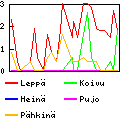User Identification through Web Browser User-Agent
Traduction: [ Google | Babelfish ]
Catégories : [ Informatique ]
I found las year that 33 bits are enough to uniquely identify someone.
Now I just read that the browser's User-Agent field provides 5 to 15 bits of identification (10.5 bits on average). If you add zip code, geolocation, it becomes nearly enough to track people perfectly.
With EFF's Panopticlick, I know that my browser provides at least 16.12 bits of identification. The identifying criteria are the User-Agent and HTTP_Accept fields, available plugins, time zone, screen size, system fonts, cookies enabled/disabled and so-called super-cookies. The most scary part of the report is the statement that “Your browser fingerprint appears to be unique among the 71,157 tested so far.”
Without Javascript, my browser still provides 16.13 bits, due to the HTTP_Accept header and User-Agent.
[ Posté le 9 février 2010 à 12:56 | 1 commentaire | lien permanent ]







19.62 bits today with Javascript on, the User-Agent and Accept fields are each unique among 804,003 browsers (and so is my collection of plugins).